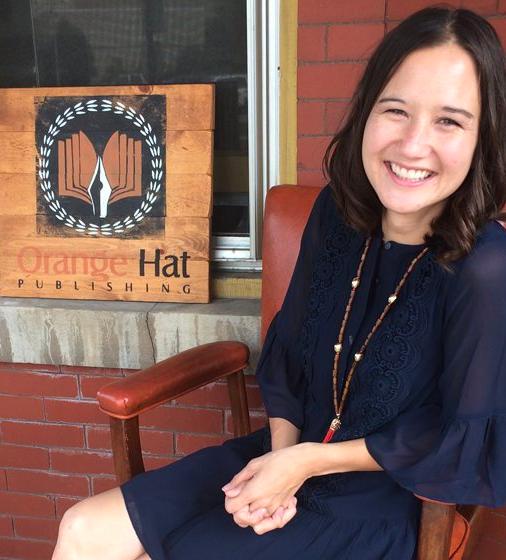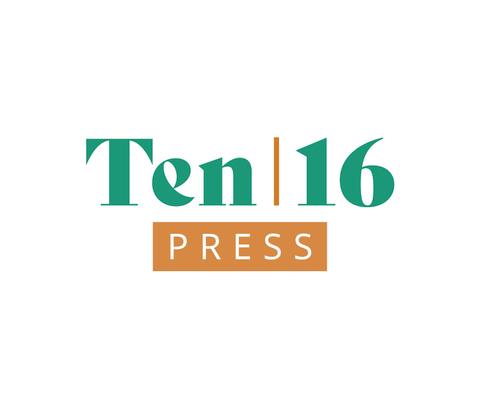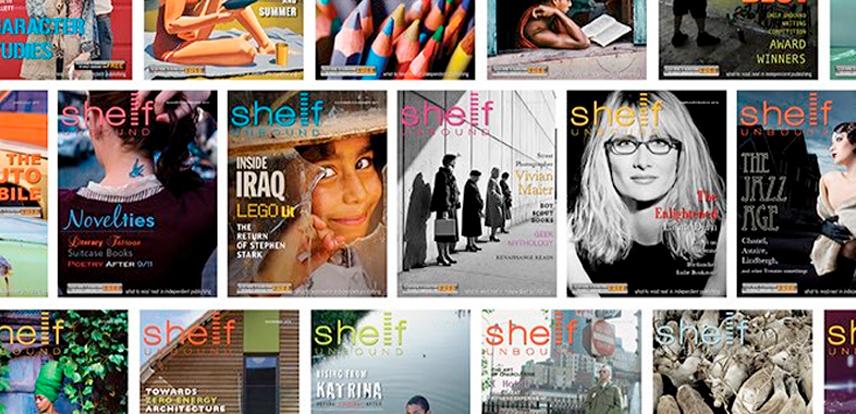
8 minute read
Small Press Reviews
TEN16 PRESS
TEN16 Press, a division of Orange Hat Publishing, housing fiction, non-fiction, YA and poetry books.
WWW.ORANGEHATPUBLISHING.COM

Behind the Scenes of Behind the Lens.
Written by: Hannah Cook, editorial intern with Orange Hat Publishing | Ten16 Press
It’s a given that any novel starring a photojournalist must have a cover worthy of the character. It may come as a surprise, then, that rather than using an actual photo, designers opted for a graphically designed cover for Behind the Lens, the debut novel by real-life photojournalist Jeannée Sacken.
In Behind the Lens, seasoned American photojournalist Annie Hawkins Green returns to Afghanistan in 2015 after having suffered through a traumatizing Taliban ambush eight years prior. Readers will be drawn into Sacken’s carefully crafted story of intrigue, suspense, and danger amidst the complex patriarchal culture of wartime Afghanistan. With so much happening within the story, it was a challenge for designers to create a cover that exemplifies all of its most important elements.
Original cover designs spotlighted photographs of two Afghan women, but that idea was eventually scrapped for a few reasons. First, its identity as a photo made the work appear nonfictional upon first glance. Even though a photograph would make sense for the story, because it is a fictional work, designers ultimately decided that an actual photograph might mislead the readers. Second, the novel follows Annie’s journey, so it was decided that she must remain the focus of the cover, while the back cover highlights the Afghan village where the story takes place.
The decision to showcase Annie came with the opportunity to feature the most important elements of her character, giving readers the chance to know her before even cracking the spine. First and foremost, of course, is the camera, illustrating Annie’s career as a photojournalist and its powerful, driving force in the novel. More subtle, however, are the messages showcased by prominently presenting Annie’s bright red hair. The color
of Annie’s hair sets her apart in the Afghan village of Wad Qol, making her an easy target for those who oppose her work and increasing the danger in which she puts herself. It also indicates her fiery and tenacious personality, one of the many reasons readers will fall in love with her character.
Drawing on her many years of travel as a photojournalist, Sacken writes with an authority that can only be gained from experiencing adventure firsthand. Despite never having been to Afghanistan herself, her travels in other countries combined with meticulous research result in impressively detailed and atmospheric descriptions of the culture of Afghanistan, especially as it pertains to women.
So, if this cover catches your eye, don’t miss out! You can’t always judge a book by its cover, but in this case, the attractiveness of the outside lives up to the excellence within.
Behind the Lens by Jeannée Sacken will be launched virtually on March 9th, 2021 by Ten16 Press, an imprint of Orange Hat Publishing. It is now available for pre-order online and can soon be found in your local bookstore.
To check out some of Jeannée’s photojournalism work, go to jeanneesacken.com.
ABOUT THE BOOK
BEHIND THE LENS
Eight years ago, seasoned photojournalist Annie Hawkins Green barely survived a Taliban ambush that left her military escort dead and a young Afghan girl dying in her arms. Since then, she has managed to suppress her memories of that brutal day-until she returns to Afghanistan to teach a photography workshop at the secondary school for girls run by her expat best friend Darya Faludi. As the Taliban gain prominence in the once peaceful region, Annie's nightmares from her last time in-country come roaring back with a vengeance. But are they just dreams? The unshakeable feeling of a grim, watchful presence makes Annie think otherwise.
As Annie struggles with her nightmares, more trouble brews with the suspicion that Darya's teenage daughter is sneaking away at night to meet her shadowy boyfriend. Meanwhile, Annie's own daughter wages war with her father and stepmother back home, feeding Annie's all-consuming mom-guilt. Her only comfort, a poetry-writing U.S. Naval officer who saved her life all those years ago, is now at the other end of a satellite phone 7,000 miles away. How can he possibly keep her safe? How can anyone?

SMALL PRESS REVIEW
Author Q&A with Jeannée Sacken.

BY HANNAH COOK
TELL US A LITTLE ABOUT YOURSELF!
JS: For as long as I can remember, I have loved stories— reading, writing, and telling them. My best friend and I competed against each other to see who could read the most books in our library’s summer reading program. At sleep-away camp, the other kids parked their sleeping bags as close to mine as possible, all the better to hear my ghost stories. In fourth grade, my class voted to forego recess so I could read them a story I’d written. My decision to major in comparative literature in college was a natural choice. How better to be able to read novels all the time and get credit for it! After earning a doctorate and teaching English and French, I ultimately resigned my tenure and left academia to pursue photojournalism and creative writing. For the last twenty years, camera in hand, I’ve traveled the world, documenting the lives of women and children through
SMALL PRESS REVIEW CONTINUED
images and words. And that has led to my writing my first novel.
HOW DID YOUR BACKGROUND WITH TRAVEL AND PHOTOGRAPHY INFLUENCE BEHIND THE LENS?
JS: Photography. Travel. It seemed logical for Annie Hawkins Green to be a photographer who travels the world. The next step was to make her a war photographer going to conflict zones. Annie gets an adrenaline rush when she photographs military forces but also when she captures images of everyday people just trying to survive and live their lives. But war takes a toll on journalists, hence Annie’s drinking and her PTSD. Although I’m not a war photographer, I’ve experienced my share of intriguing situations during my travels. To name two: the lodge where I was staying in Namibia burned down around me in the middle of the night, and while in Botswana, I had to be medevaced out of the Kalahari Desert in a helicopter. Some of my experiences have found their way into this novel.
WHAT INSPIRED YOU TO MAKE THE SETTING OF BEHIND THE LENS IN AFGHANISTAN?
JS: Actually, Behind the Lens is set in Milwaukee, Wisconsin, where I live, as well as in Afghanistan. Because Annie is a war photographer, I needed to set her story in a conflict zone. Afghanistan has been riddled by war and violence for many years. Despite the toll war has taken, Afghans are known for being incredibly hospitable and have maintained their rich and diverse cultural traditions. That appealed to me. In addition, I wanted to have girls’ education be a central part of this novel. The fact that even nowadays the majority of Afghan girls are still unable to attend school is a story that needs telling.
WHAT WAS THE RESEARCH PROCESS LIKE FOR THIS BOOK?
JS: I read my way through stacks and stacks of books, followed every lead I came across online, attended “Meet Your Muslim Neighbors” workshops hosted by members of the Masjid Al-Huda in South Milwaukee, visited a U.S. naval ship, watched endless Afghan dance performances and YouTube road trips along the river in the Panjshir Valley, baked loaves of roht, cooked Afghan dinners, studied maps, and read the Qur’an. And that was just the beginning.
HOW MANY COUNTRIES HAVE YOU TRAVELED TO? WHAT’S ONE COUNTRY YOU HAVEN’T
SMALL PRESS REVIEW CONTINUED
VISITED YET BUT WOULD LIKE TO?
JS: My husband and I travel together. He likes to joke that he carries my camera gear. He should! It’s very heavy. Often, we select a destination based on a specific photography project. That was the case when we went to farwestern Mongolia to attend the Golden Eagle Festival and also when we went to Namibia to photograph the Himba. We’ve traveled to about fifty countries, but that’s misleading because there are places we love so much that we keep going back. There are so many places still to visit that it’s impossible to name just one. Recently, we decided we’d like to photograph snow leopards and tigers as well as the women and children in Ladakh, a remote section in northern India. We’d also like to visit Borneo and Bhutan, Uganda and Gabon. Our list is very long.
YOU’VE DECIDED THAT A PORTION OF THE PROCEEDS FROM BEHIND THE LENS WILL BE DONATED TO FUND GIRLS’ AND WOMEN’S EDUCATION. TELL US ABOUT THAT!
JS: Both my husband and I are committed to furthering education in any way we can. Wherever our journeys take us, we make a point of visiting schools and donating books and other supplies. The situation of girls’ education and women’s ability to work in conflict zones is particularly dire. Illiteracy rates run high. As do birth and mortality rates. In a country like Afghanistan, girls were actually banned from getting an education under Taliban rule. And now, nearly twenty years later, there are few secondary schools for girls—they’ve all been destroyed. Just getting to school is fraught with danger; girls are sometimes attacked with stones and acid. Plus, there’s a Catch-22: girls over the age of about twelve must have female teachers, and quite simply, 80% of teachers in Afghanistan are male. It is not just in Afghanistan that girls face these obstacles; many countries have erected barriers to women and girls receiving the education they need to be self-supporting and to have a say in the control of their own lives. There are 501(c)(3) organizations working to help educate women and girls. Global Giving International sponsors many programs, among them “Grow Peace in Afghanistan: Educate 3,000 women.” The Global Fund for Children works to rectify inequalities and funds education programs. Women for Women provides grants to local NGOs to train women to work and provide for themselves and their families. The Malala Fund recruits female teachers and funds girls’ educational opportunities.

Never miss an issue!
SIGN UP FOR A FREE SUBSCRIPTION TO SHELF UNBOUND MAGAZINE.











